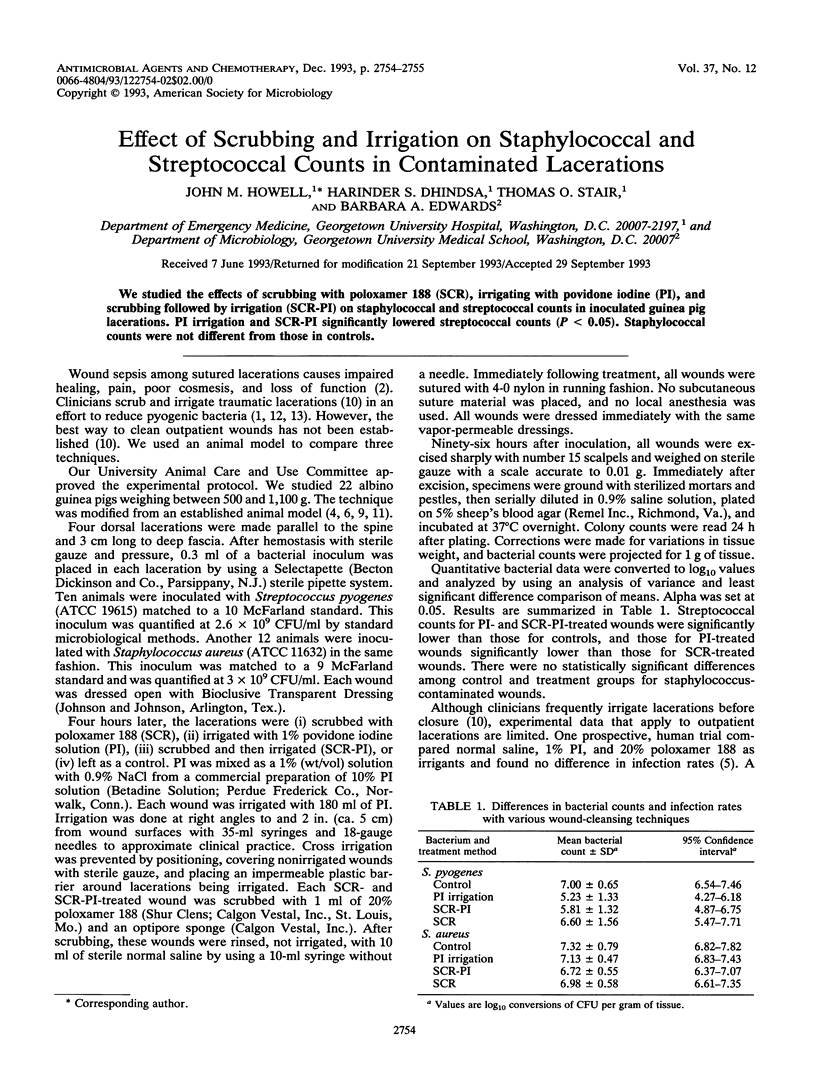Abstract
We studied the effects of scrubbing with poloxamer 188 (SCR), irrigating with povidone iodine (PI), and scrubbing followed by irrigation (SCR-PI) on staphylococcal and streptococcal counts in inoculated guinea pig lacerations. PI irrigation and SCR-PI significantly lowered streptococcal counts (P < 0.05). Staphylococcal counts were not different from those in controls.
Full text
PDF

Selected References
These references are in PubMed. This may not be the complete list of references from this article.
- Berkelman R. L., Holland B. W., Anderson R. L. Increased bactericidal activity of dilute preparations of povidone-iodine solutions. J Clin Microbiol. 1982 Apr;15(4):635–639. doi: 10.1128/jcm.15.4.635-639.1982. [DOI] [PMC free article] [PubMed] [Google Scholar]
- Bucknall T. E. The effect of local infection upon wound healing: an experimental study. Br J Surg. 1980 Dec;67(12):851–855. doi: 10.1002/bjs.1800671205. [DOI] [PubMed] [Google Scholar]
- Burke J. F. The effective period of preventive antibiotic action in experimental incisions and dermal lesions. Surgery. 1961 Jul;50:161–168. [PubMed] [Google Scholar]
- Custer J., Edlich R. F., Prusak M., Madden J., Panek P., Wangensteen O. H. Studies in the management of the contaminated wound. V. An assessment of the effectiveness of pHisoHex and Betadine surgical scrub solutions. Am J Surg. 1971 May;121(5):572–575. doi: 10.1016/0002-9610(71)90142-5. [DOI] [PubMed] [Google Scholar]
- Dire D. J., Welsh A. P. A comparison of wound irrigation solutions used in the emergency department. Ann Emerg Med. 1990 Jun;19(6):704–708. doi: 10.1016/s0196-0644(05)82484-9. [DOI] [PubMed] [Google Scholar]
- Edlich R. F., Custer J., Madden J., Dajani A. S., Rogers W., Wangensteen O. H. Studies in management of the contaminated wound. 3. Assessment of the effectiveness of irrigation with antiseptic agents. Am J Surg. 1969 Jul;118(1):21–30. doi: 10.1016/0002-9610(69)90089-0. [DOI] [PubMed] [Google Scholar]
- Edlich R. F., Madden J. E., Prusak M., Panek P., Thul J., Wangensteen O. H. Studies in the management of the contaminated wound. VI. The therapeutic value of gentle scrubbing in prolonging the limited period of effectiveness of antibiotics in contaminated wounds. Am J Surg. 1971 Jun;121(6):668–672. [PubMed] [Google Scholar]
- Edlich R. F., Smith Q. T., Edgerton M. T. Resistance of the surgical wound to antimicrobial prophylaxis and its mechanisms of development. Am J Surg. 1973 Nov;126(5):583–591. doi: 10.1016/s0002-9610(73)80002-9. [DOI] [PubMed] [Google Scholar]
- Edlich R. F., Tsung M. S., Rogers W., Rogers P., Wangensteen O. H. Studies in management of the contaminated wound. I. Technique of closure of such wounds together with a note on a reproducible experimental model. J Surg Res. 1968 Dec;8(12):585–592. doi: 10.1016/0022-4804(68)90013-9. [DOI] [PubMed] [Google Scholar]
- Howell J. M., Chisholm C. D. Outpatient wound preparation and care: a national survey. Ann Emerg Med. 1992 Aug;21(8):976–981. doi: 10.1016/s0196-0644(05)82938-5. [DOI] [PubMed] [Google Scholar]
- Howell J. M., Stair T. O., Howell A. W., Mundt D. J., Falcone A., Peters S. R. The effect of scrubbing and irrigation with normal saline, povidone iodine, and cefazolin on wound bacterial counts in a guinea pig model. Am J Emerg Med. 1993 Mar;11(2):134–138. doi: 10.1016/0735-6757(93)90106-l. [DOI] [PubMed] [Google Scholar]
- Nylén S., Carlsson B. Time factor, infection frequency and quantitative microbiology in hand injuries: a prospective study. Scand J Plast Reconstr Surg. 1980;14(2):185–189. doi: 10.3109/02844318009106707. [DOI] [PubMed] [Google Scholar]
- Robson M. C., Duke W. F., Krizek T. J. Rapid bacterial screening in the treatment of civilian wounds. J Surg Res. 1973 May;14(5):426–430. doi: 10.1016/0022-4804(73)90049-8. [DOI] [PubMed] [Google Scholar]
- Rodeheaver G., Edgerton M. T., Elliott M. B., Kurtz L. D., Edlich R. F. Proteolytic enzymes as adjuncts to antibiotic prophylaxis of surgical wounds. Am J Surg. 1974 May;127(5):564–572. doi: 10.1016/0002-9610(74)90318-3. [DOI] [PubMed] [Google Scholar]
- Rodeheaver G., Marsh D., Edgerton M. T., Edlich R. F. Proteolytic enzymes as adjuncts to antimicrobial prophylaxis of contaminated wounds. Am J Surg. 1975 May;129(5):537–544. doi: 10.1016/0002-9610(75)90313-x. [DOI] [PubMed] [Google Scholar]
- Stevenson T. R., Thacker J. G., Rodeheaver G. T., Bacchetta C., Edgerton M. T., Edlich R. F. Cleansing the traumatic wound by high pressure syringe irrigation. JACEP. 1976 Jan;5(1):17–21. doi: 10.1016/s0361-1124(76)80160-8. [DOI] [PubMed] [Google Scholar]


